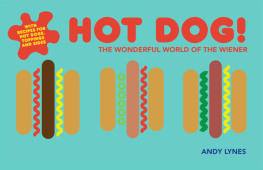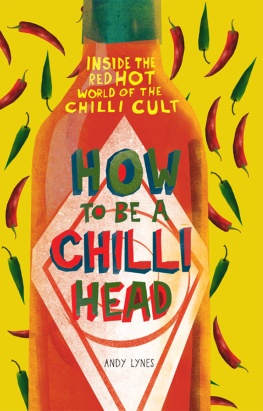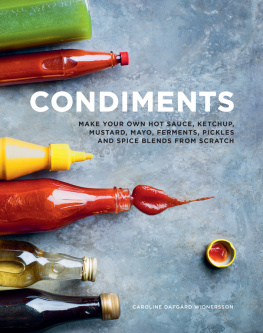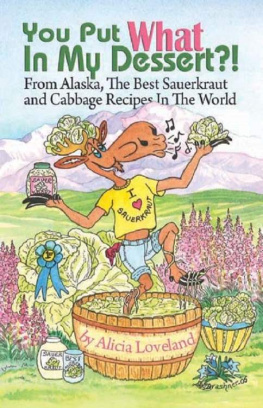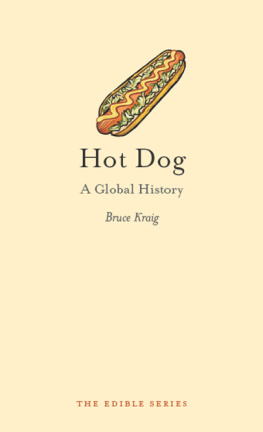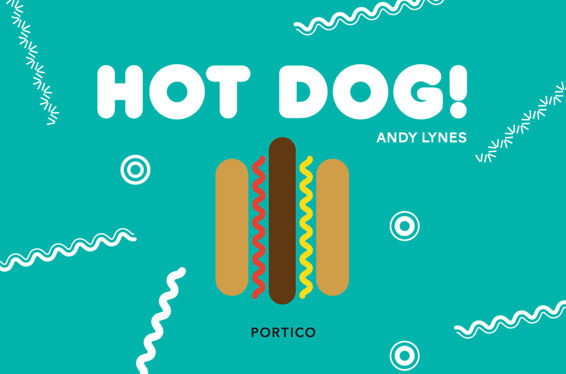


Hot dogs are one of the most popular and familiar finger foods in the world. As youll learn from reading this book, their invention is steeped in myth and mystery, as is the reason they acquired their frankly bizarre name. (Ever smelled a real hot dog? The last thing the aroma of an overheated Labrador will make you is hungry.) But despite the hazy origins and odd nomenclature, hot dogs are one of Americas greatest culinary gifts to the world.
With 40 fun and tasty recipes, this book provides you with everything youll need for an authentic hot dog experience, apart from a New York street or baseball stadium to eat it in, that is. Youll learn not only how to prepare a classic American-style hot dog, but also how to reinvent a dog as a true gastronomic treat with culinary ideas drawn from around the globe. By using the range of you can create your own gourmet dogs, and by adding a few side dishes make a real meal out of them.
Once youve got the hot dog bug, why not hit the road and check out some of the finest around the world and see how the professionals do it, including some top chefs whove put their own stamp on the humble dog.
With billions sold around the world every year, hot dogs are big business. Turf wars between street vendors fighting over prime locations have sprung up in major cities around the world including London and New York. You can even go to Hot Dog University in Chicago and learn the art of the cart and how to run your own stand or restaurant.
There are plenty of punters who take hot dogs very seriously; Google New York vs. Chicago hot dog for a torrent of impassioned debate. There are even hot dog historians like Bruce Kraig, Ph.D., professor emeritus at Roosevelt University in Illinois, and etymologist and consulting editor of the Oxford Encyclopaedia of Food and Drink in America, Barry Popik.
But there is something inherently funny about a hot dog. Maybe its the phallic shape, maybe its that dumb name, or the fact that a hot dog sausage is called a wiener in America, but hot dogs simply refuse to be taken too seriously. (For proof, check out .) In a world where food snobbery increasingly threatens to suck all the fun out of eating, that can only be a good thing.
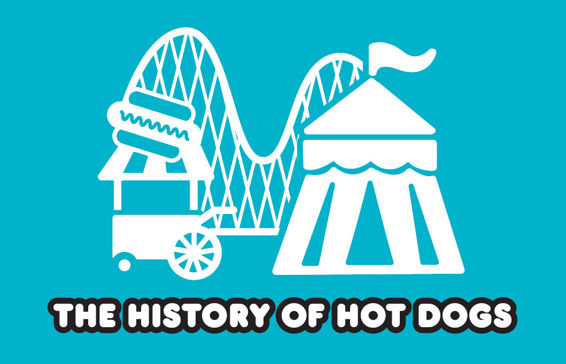
Hot dogs as we know them today, a sausage in a bun, were invented in the 1870s in Coney Island, Brooklyn, New York by seaside food vendor Charles Feltman. But it could have been a decade later by another Coney Island resident, Ignatz Frischman, who its said was the first to realize that the popular frankfurter sausage sandwiches sold in the neighbourhood would make more sense served in a long bun.
But maybe it was in Chicago in 1893 at the Worlds Columbian Exposition, held to celebrate the 400th anniversary of Christopher Columbuss arrival in the New World. Or perhaps it was at the St. Louis Louisiana Purchase Exposition in 1904, when Anton Feuchtwanger asked his baker brother-in-law to come up with something to replace the gloves he loaned to his customers so they could hold the hot sausages, and which they never returned. Or was it was even earlier than all of that? Some say a German immigrant sold hot dogs from a push cart in the 1860s in the Bowery district of New York.
When it comes to hot dog history, theres plenty of it, its just that no one seems to be able to agree on the precise facts. Perhaps the truth is that putting a sausage in a roll is such a simple notion that numerous people came up with it at different times, and it was only when hot dogs became hugely popular that anyone tried to lay claim to the snack foods invention.
The hot dog sausages origins go back much further than America in the 19th century, though. Vienna in Austria laid claim to its invention with a huge party in 1987 celebrating the 500th anniversary of the birth of the wiener or Vienna sausage. However the German city of Frankfurt could (and does) equally call itself the birthplace of the hot dog as its home to the frankfurter sausage, also created in the 14th century.
The origins of the name hot dog have also been obscured by time. Tad Dorgan, a cartoonist on the New York Journal, was credited with coining the term when he reputedly drew a dachshund dog (the short-legged, long-bodied breed thought to have been brought to North America by the same immigrants who brought the wiener and frankfurter) in a roll and captioned it get your hot dogs in the early 1900s. The only problem with the story is that, despite Dorgans popularity, no one can find a copy of his cartoon in the archives of the prolific artists work.
What historians have discovered is a reference in a 1895 copy of college magazine the Yale Record that described students who munched hot dogs which were sold from carts outside the University dormitories. Those that indulged were dubbed the Kennel Club, and the term hot dog is thought to be a poke at the dubious source of the meat the sausages were made from. They were probably joking, but the Coney Island Chamber of Commerce failed to see the funny side, and in 1913 forbade traders from using the words hot dog on their signs. To this day, the National Hot Dog and Sausage Council (yes, there really is such a thing) say the most frequently asked question of them is what really goes into a hot dog?, although if there are still any reservations about the make-up of the sausage, it doesnt stop Americans eating about 20 billion of them a year.
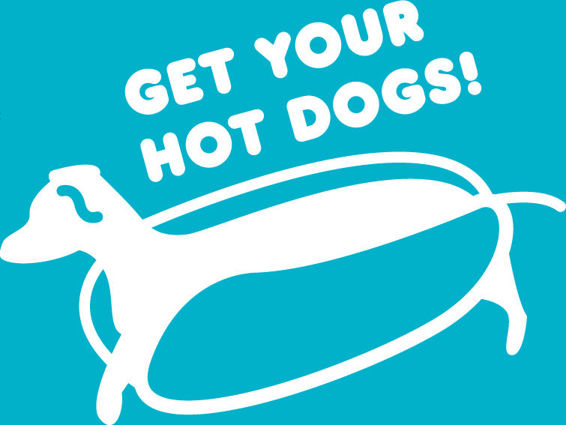
CURRYWURST

If you havent tried this snack on the streets of Berlin or Cologne, you are in for a surprisingly delicious treat. Usually served as slices of fried Bratwurst sausage on a carton of chips, slathered in currywurst sauce, dusted with curry and chilli powders, this is the same thing, just served in a roll.
Serves 4
2 tbsp vegetable oil
1 onion, finely chopped
2 tbsp curry powder, plus more for dusting
200g/7oz/scant 1 cup passata
200g/7oz/scant 1 cup
1 tsp Worcestershire sauce
1 tsp sea salt
4 Bratwurst sausages
4 hot dog buns
4 tsp mild chilli powder
Heat half of the oil in a pan over medium heat and add the onion. Cook, stirring continuously, for 3 minutes until the onion is soft but not coloured. Add the curry powder and cook for a further minute, then add the passata, ketchup, Worcestershire sauce and salt and leave to simmer gently for 30 minutes. Check the seasoning and keep warm.
Heat the remaining oil in a frying pan and cook the sausages for 15 minutes until brown and cooked through. Slice the buns lengthways, put one sausage in each bun, top with the sauce and sprinkle over the curry powder and chilli powder. Serve with .
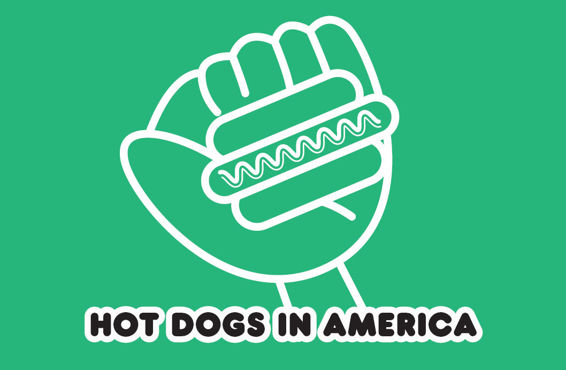
Next page
